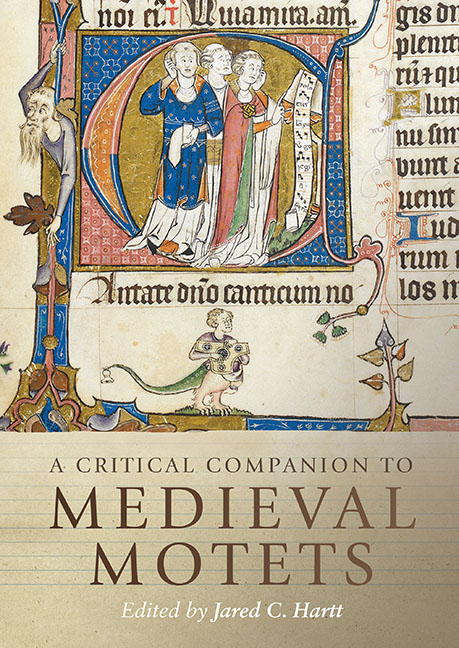Book contents
- Frontmatter
- Dedication
- Contents
- List of Figures
- List of Music Examples
- List of Tables
- List of Contributors
- Preface
- Acknowledgments
- Abbreviations
- Introduction: Approaching Medieval Motets
- 1 The Genre(s) of Medieval Motets
- 2 Origins and Interactions: Clausula, Motet, Conductus
- 3 Tracing the Tenor in Medieval Motets
- 4 Isorhythm
- 5 Notation
- 6 Thirteenth-Century Motet Functions: Views through the Lens of the Portare Motet Family
- 7 A Prism of its Time: Social Functions of the Motet in Fourteenth-Century France
- 8 Motets, Manuscript Culture, Mise-en-page
- 9 Clerics, Courtiers, and the Vernacular Two-Voice Motet: The Case of Fines amouretes / Fiat and the Roman de la poire
- 10 When Words Converge and Meanings Diverge: Counterexamples to Polytextuality in the Thirteenth-Century Mote
- 11 Motets in Chansonniers and the Other Culture of the French Thirteenth-Century Motet
- 12 Building a Motet around Quoted Material: Textual and Musical Structure in Motets Based on Monophonic Songs
- 13 The Duet Motet in England: Genre, Tonal Coherence, Reconstruction
- 14 Materia Matters: Reconstructing Colla/Bona
- 15 Machaut’s Motet 10 and its Interconnections
- 16 A Motet Conceived in Troubled Times: Machaut’s Motet 22
- 17 A Motet Ahead of its Time? The Curious Case of Portio nature/Ida capillorum
- Bibliography of Works Cited
- Select Glossary
- Index of Cited Motets
- General Index
- Studies in Medieval and Renaissance Music
Introduction: Approaching Medieval Motets
Published online by Cambridge University Press: 21 October 2020
- Frontmatter
- Dedication
- Contents
- List of Figures
- List of Music Examples
- List of Tables
- List of Contributors
- Preface
- Acknowledgments
- Abbreviations
- Introduction: Approaching Medieval Motets
- 1 The Genre(s) of Medieval Motets
- 2 Origins and Interactions: Clausula, Motet, Conductus
- 3 Tracing the Tenor in Medieval Motets
- 4 Isorhythm
- 5 Notation
- 6 Thirteenth-Century Motet Functions: Views through the Lens of the Portare Motet Family
- 7 A Prism of its Time: Social Functions of the Motet in Fourteenth-Century France
- 8 Motets, Manuscript Culture, Mise-en-page
- 9 Clerics, Courtiers, and the Vernacular Two-Voice Motet: The Case of Fines amouretes / Fiat and the Roman de la poire
- 10 When Words Converge and Meanings Diverge: Counterexamples to Polytextuality in the Thirteenth-Century Mote
- 11 Motets in Chansonniers and the Other Culture of the French Thirteenth-Century Motet
- 12 Building a Motet around Quoted Material: Textual and Musical Structure in Motets Based on Monophonic Songs
- 13 The Duet Motet in England: Genre, Tonal Coherence, Reconstruction
- 14 Materia Matters: Reconstructing Colla/Bona
- 15 Machaut’s Motet 10 and its Interconnections
- 16 A Motet Conceived in Troubled Times: Machaut’s Motet 22
- 17 A Motet Ahead of its Time? The Curious Case of Portio nature/Ida capillorum
- Bibliography of Works Cited
- Select Glossary
- Index of Cited Motets
- General Index
- Studies in Medieval and Renaissance Music
Summary
THE TITLE OF THIS VOLUME may seem rather straightforward, but it has been deliberately chosen to reflect one of the book's main points. A Critical Companion to Medieval Motets – rather than A Critical Companion to the Medieval Motet – signals that the motet, essentially, cannot be regarded as a single thing: not only do motets change drastically throughout the thirteenth and fourteenth centuries (and beyond), but even motets that are contemporaneous with one another often exhibit such wildly different characteristics that one would be hard-pressed to come up with a suitable definition for the genre.
What then are medieval motets? Combing through various musical dictionaries and textbooks, one will typically find the motet defined as a polyphonic composition with two differently texted upper voices operating over a pre-existing tenor line drawn from chant. To be sure, there exist hundreds of medieval motets that fit this description. But there also exist hundreds of motets that do not. Perhaps the most effective way to convey a sense of the sheer breadth of the genre is through a glance at a handful of contrasting examples discussed throughout the volume; these motets range from the first decades of the thirteenth century to the onset of the fifteenth century, the scope of the Companion.
Take for instance the subgenre of two-voice motets. Salve salus, hominum/Et gaudebit is a short work that appears in F, one of the earliest motet sources. As shown in Example 4.3 (p. 81 below), the melody of its tenor, Et gaudebit, is drawn from the Alleluia for the feast of the Ascension and proceeds in a pattern that alternates long and short notes. The motet's texted Latin upper voice (the motetus or duplum, interchangeably) is declaimed in the same basic rhythms with poetic lines that are almost all of the same length. Like the majority of medieval motets, its composer remains unknown to us today. We can compare this with another two-voice motet, Fines amourete/Fiat, that appears in the slightly later W2 manuscript. As is illustrated in Example 9.1 (p. 195), its upper voice is in French and contains a refrain in lines 9, 10, and 11 (enclosed in quotation marks) that also appears within the allegorical verse narrative Roman de la poire; this motet exhibits the close relationship between the genres of motet and secular song.
- Type
- Chapter
- Information
- A Critical Companion to Medieval Motets , pp. 1 - 13Publisher: Boydell & BrewerPrint publication year: 2018

